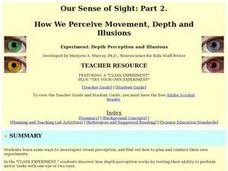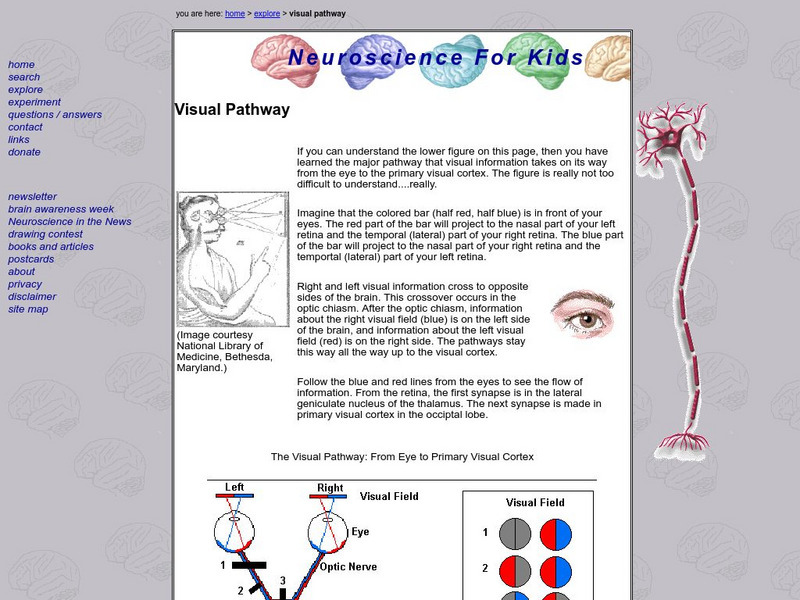Curated OER
Lesson: Urs Fischer: Your Choice: Reality or Illusion?
Young analysts write a comparative essay, but about what? They compose a paper based on several critical discussion about reality and illusion, and how both are blurred in art. They analyze several theatre pieces that exemplify Brechtian...
University of Minnesota
Beautiful Brain: Do You See What I See?
Can art play tricks on your eyes, and can a still painting really appear to vibrate? The second lesson in a four-part series discusses the way our beautiful brains translate visual images. It highlights the style of optical art and...
Curated OER
How We Perceive Movement, Depth and Illusions
Middle schoolers examine how depth perception works through a class experiment. They design and perform their own experiment that investigates visual illusions.
Curated OER
Perception and the Brain
Students experience how the brain adapts over time to changes in what they perceive. In this human perception lesson, students wear special prism goggles that initially disorient the user. Over time, the student is able to adjust to the...
Curated OER
Optical Illusion Vase
Learners draw an optical illusion. In this optical illusion instructional activity, students create the optical illusion vase. Learners draw a profile and repeat the drawing in reverse creating the vase image.
LABScI
Vision Lab: The Eye
Our bodies have some amazing capabilities, but there are some limitations. Explore the limitations of the human eye through the eighth lab activity in a series of 12 biology lessons. Individuals measure their own peripheral vision...
Curated OER
Applied Science - Science and Math Post-Lab
Students explore optical illusions. In this Applied Science lesson, students view optical illusions and record the data of what they see. Students graph the data that they collect.
Curated OER
Fraggle Monster Vase
Students create an optical illusion. In this optical illusions instructional activity, students sketch a monster's face to create the optical illusion of a vase in the positive space. Students create an original piece of art.
Curated OER
How We See
Students study how images they see are transmitted to the brain. In this sight lesson students complete several activities that have to do with visual pathways and field defects.
Curated OER
Now You See It, Now You Don't
Students determine their eye's blind spot. In this biology lesson, students explain what causes this visual deficiency. They give real life applications of this concept.
Curated OER
Contour Drawing
Students create a contour drawing of a hand creating an illusion of depth. After a brief demonstration of contour drawing, students practice by creating pictures of various objects. The final project consists of creating a contour...
Curated OER
Does Negative Space Have A Shape?
Students observe negative space in drawing. In this negative space lesson, students discover that sketches include negative space or background. Students produce a drawing while paying attention to the negative space.
Curated OER
Mystery of the Senses-Vision
Students view six optical illusions and explain why the visual system might interpret them the way it does. They explore how illusions distort our sense of perspective, because they deceive us into seeing what we expect to see. ...
TED Talks
Ted: Ted Ed: How Optical Illusions Trick Your Brain
Optical illusions are images that seem to trick our minds into seeing something different from what they actually are. But how do they work? This learning module walks us through a few common optical illusions and explains what these...
Exploratorium
Exploratorium: Optical Illusions
Try these great optical illusions yourself, and read the explanation of how your brain fools your eyes. You will need Shockwave to run these properly.
TED Talks
Ted: Ted Ed: Why Do We See Illusions?
Why can't our extremely complex eyes render simple optical illusions? Surprise, surprise- it comes back to the brain, which has only evolved to encounter natural stimuli. Mark Changizi explains how the brain reckons with optical...
University of Washington
University of Washington: Central Visual Pathways
Explore the world of central visual pathways. The visual pathway leads from the eye to the primary visual cortex. There is a detailed visual description of this process. Check it out.
PBS
Pbs Teachers: Mystery of the Senses Vision
Understand how our brain identifies an object, view six optical illusions and explain why the visual system might interpret them the way it does.



















